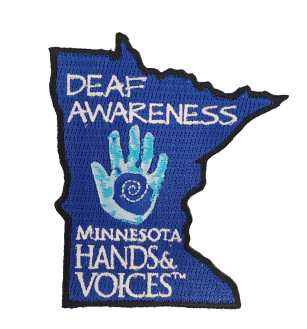Deaf Awareness Patch

Ships in USA & Canada only
To place an order, please contact Sophia Barr at sophia.barr@lssmn.org.
This program is for Boy Scouts, Girl Scouts, and other youth clubs and groups. Groups will need to complete the required amount of activities based on their ages to complete the program. This program is designed to help youth groups to increase their awareness and understanding of Deafness. Deafness or Hard of Hearing, is sometimes abbreviated DHH, as it is in this program.
Instructions
- Grades K-3 (Girl Scout Daisies and Brownies) should complete one activity from each of the 5 sections
- Grades 4-8 (Girl Scout juniors and Cadettes) should complete two activities from each of the 5 sections
- Grades 9-12 (Girl Scout Seniors and Ambassadors) should complete three from each of the 5 sections
- Also, for this age level at least one activity should be done individually and the findings should be shared with the troop.
1. Assistive Technology
A-brainstorm what technologies people who are deaf or hard of hearing use. How many can you name? Now learn more about some like hearing aides, cochlear Implants, FM systems, closed captions, lights for sounds and discuss it in your troop.
B - look through the Diglo Website, www.diglo.com (formerly known as Harris Communication) and compare several products from it. Did any surprise you?
C- watch TV with the sound off and the captions on. Are the captions enough to replace the sound for you? Did they seem accurate?
D- research what apps may be helpful to people who are DHH and why. List 3 and compare them.
E-try to design a product that would be useful to people who are DHH. Write a product description or draw a picture of it and explain what it does.
2. Famous People/History
A-try to name famous or historical people who are deaf or hard of hearing. How many can you name? What about any fictional characters?
B-watch a show with at least one actor or character who is Deaf.
Examples: Signing Time or Dr. Wonder's Workshop. Or Switched at Birth(for older children)
C-Read a biography about someone who is DHH.
D-read a fiction book with at least one character who is DHH.
Examples: El Deafo or Nobody's Perfect.
E-Attend a class, meeting, play, or performance with an ASL interpreter. Discuss it with your fellow Girl Scouts.
F-have a guest who is DHH visit with your troop and have them share about their life.
If you are a Girl Scout troop-
G-Hold a Girl Scout founders day event on or around October 31st for your troop or or other scouts. Share about Juliette Gordon Low’s hearing loss.
3. Communication Options
A-learn the difference between 3 of the most popular of some of the communications options for people who are DHH; ASL, Cued Speech, lip reading.
B-learn about how people who are DeafBlind communicate. Professionals who communicate with them are called interveners; what do they do?
C-learn your name in ASL finger spelling and Cued Speech.
D -try lip reading simple words with a partner. How hard is it? How long would you need to practice to be good at it?
E- Many people who are DHH can not use a telephone the way you do. Learn about 2 other ways people who are DHH communicate like video phones and captioned phones and compare them.
If you are a Girl Scout troop-
F - learn the Girl Scout promise and law in ASL
4. Diagnosis/Professionals
A -Learn about the statistics of hearing loss in your city, state, and country
B-learn about the different types and degrees of hearing loss (mild, moderate, severe, and profound). There are also unilateral and bilateral types of loss . And as well as sensory neural and conductive types of loss. What do these terms mean?
C-visit a doctor who works with ears and hearing like an ENT or an audiologist and learn about what they do.
D-Get a hearing test from a professional. Did anything about it surprise you?
E -Meet an ASL interpreter and learn about what he/she does. How/why did he/she learn to sign?
F -Learn about the ear, its anatomy, how it works, and what can cause hearing loss.
G -learn how and when to protect your hearing. Name 3 things you an do.
H -What agencies or professionals work with people who are DHH in your community. Try to list 3. What do they do?
I-If a child who is DHH was at your local school, who would work with them? What services would be provided to them?
5 Social/Educational
A-find and play an existing game that involves no hearing or speaking, if you can.
B -adapt a game to use visual signals instead of using your voice. Like for the game "red light, green light" you could hold up colored pieces of paper instead of saying red light or green light.
C -find out if there are any social groups for people who are DHH in your area? Camps, college clubs, teams or activity programs?
D - how could someone in your area learn or study ASL? Is there a college program or community education? If not, how could they learn online?
E-try to list what you would need to do differently in your daily life if you woke up with a hearing loss tomorrow. |
F-how could you make your group or troop meetings accessible and fun for another child who is DHH?
G- Make posters or present what you have learned while earning this patch.
H -explore what is meant by "Deaf Culture".
I-What are some polite and acceptable ways to get the attention of a person who is DHH?
J-look into post secondary options like NTID, RIT, CSUN, or Gallaudet University for the DHH population. What do they offer and how are they different compared to your average university?
